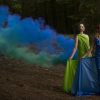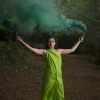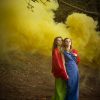
Fashion to dye for: Vintage designer pieces show how colour shaped style and status
A rainbow of vintage and designer pieces, ‘toxic’ colours and dye recipes are set to be revealed from one of the National Trust’s largest fashion collections. The latest exhibition, Fashion to dye for, has opened its doors to invite people into the wardrobe and discover how colours, dyes and design shaped fashion history.
From a 50’s red silk gown (said to have belonged to Princess Margaret), a 1960s shirt by Pucci, a skirt suit by Bernat Klein and an early Laura Ashley dress, the collection brings to life how colour can reveal much about the wearer and also looks into the origins, status and function of colour in fashion.
Would you risk your life in the name of fashion? If you think green is the colour to die for, find out how people used toxic arsenic to formulate a particular shade of green. If absorbed through the skin, it could be deadly.
Drawing on the extensive 20,000 piece collection at Killerton, selected objects will tell the story of how colour in fashion has evolved and signified different meanings over time. Find out why black is associated with mourning, white with weddings and why red is seen as racy but was also a masculine colour in the Tudor period. It also looks at cultural shifts in fashion – why young boys were often dressed in red frocks similar to girls’ clothing until aged four, when they were dressed in trousers and had long curls cut.
The production of dyes has a colourful history - natural methods of dyeing started with pigments and stains from crushed flowers, berries, roots and bark. By the eighteenth century, natural dyes were complex and recipes were well protected. Following the discovery of the first, real synthetic dye, mauveine, in 1856, chemists began to experiment to produce brighter, more permanent shades.
Visitors can learn about colourful dresses from the historic collection made of silk, wool, cotton and synthetic materials dyed both naturally and chemically. We also explore how the First World War impacted on fashionable colours, from who invented synthetic dyes to the natural origins of denim blue.
Rare treats from Killerton’s collection include:
- Designer pieces by Bernat Klein, Emilio Pucci, Laura Ashley and Ossie Clark (1960s and 1970s)
- Reception gown in red Chinese silk, 1950s, said to have belonged to HRH Princess Margaret
- Boys red wool frock, 1855
- Man’s denim jacket and flares, 1970s
- Afternoon gown of printed yellow silk, 1860s
- Evening dress in crimson jersey by Worth, 1950s
It also includes an exciting display of over 100 pieces of work by Exeter College Art and Design students, inspired by the ever-changing colour palette of Killerton’s estate.
Shelley Tobin, Costume Curator at Killerton said: “Fashion comes in many shades and not only expresses the tastes and personality of the wearer but can also show wealth, rank and status. This exhibition will showcase some of the collections most vibrant fashion and explore the colourful history behind the pieces.”
Shelley continued: “We’re also showing brand new features for this year including a Cabinet of Curiosities displaying hats, shoes and accessories from the collection. We’re certain this exhibition is going to be the most visually exciting yet.”



















